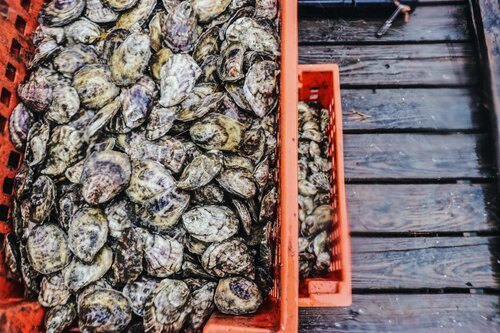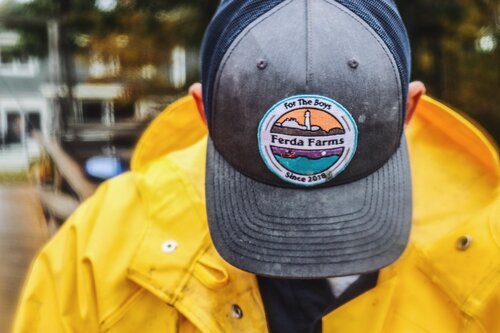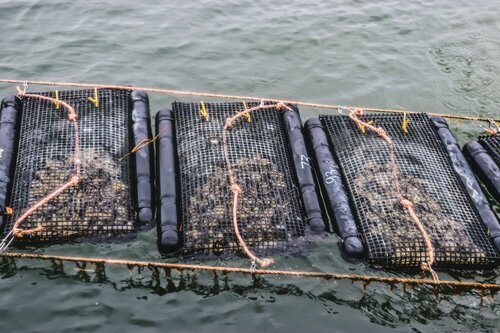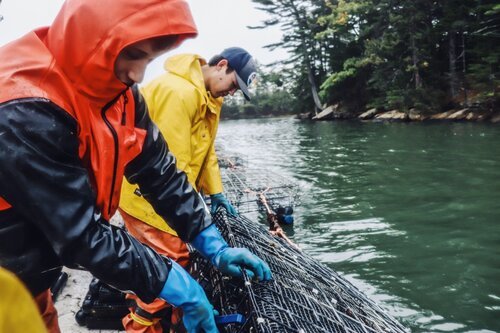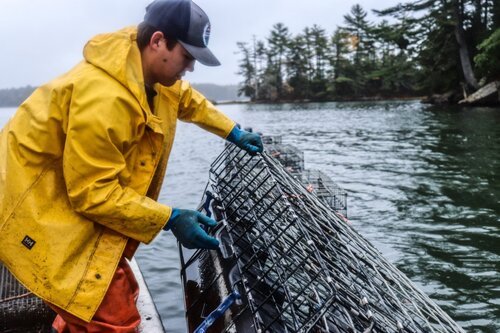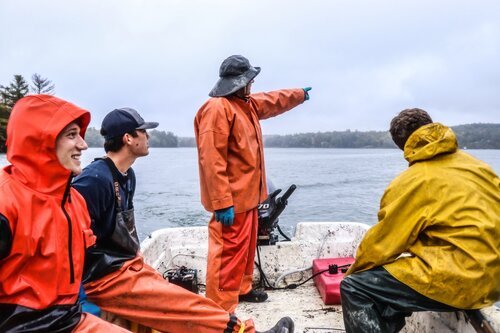For the Boys: Ferda Farms’ Quest to Revolutionize Oyster Farming
Chris Burtis, Max Burtis, and Sam Dorval, the trio that is Ferda Farms, share their insights as to how they incorporate engineering innovation, marketing ingenuity, and a commitment to sustainability in the practice of farming their oyster, the Bombazine, on the New Meadows River in Brunswick, Maine.
My first trip to Ferda Farms begins with an early morning rainstorm.
While storms in the Southeast or Midwest come quickly and pass just as fast, the morning rain in Maine lingers all day, and into the night.
My younger sister was visiting me from out-of-state. Like any older sibling, I was determined to ensure she had the time of her life. Looking back on it—I may have been over-promising, with plans of sunset sailboat cruises in the harbor, endless local wine pairings, and of course, platters of fresh oysters that I was picking up directly from a new local farm—Ferda Farms.
The second morning of my sister’s stay, we were awoken by the sound of a steady rain tapping like falling pine needles on my window. I stared out my room’s window and watched as raindrops glided their way down the glass while the background sky was swallowed by an abyss of grey. Somberly, I tiptoed out of the bedroom, and onto my patio.
The Maine morning rain shrouded the sky with a grey mist that blurred out everything, from the hills that loomed in the distance, to boats bobbing on the water. The air was heavy—it felt like the atmosphere had descended to sea level, and coaxed a faint smoke to rise from the waters.
I felt as my sister approached behind me, and sensed her frustration.
“Get dressed, put on something warm,” I instructed before she could sulk. My sister looked at me, confused.
“Come on, I’m taking you to an oyster farm.”
“In the rain?” She asked.
I nodded and smiled, “you’re about to have an authentic Maine oyster farm experience.”
Founded in 2018, Ferda Farms has already made a name for itself. The three-man team christened their farm after the hockey term “ferda,” slang for “for the boys” – a testament to their friendship and strong teamwork ethic.
Ferda Farms’ New England oyster grower colleagues have heaped accolades on the farm, and praised its meticulous organization, engineering innovation, and entrepreneurial spirit. The team won the 2019 UMaine Business Challenge, and is set to compete on Greenlight Maine, a “pitch-off” for budding local businesses. Plus, with a research partnership with the University of Maine, and a serious plan to become Maine’s first all-solar, 100% sustainable oyster farm, the admiration is certainly warranted.
But Ferda Farms’ recognition extends beyond New England. The farm’s first oyster-to-market, the Bombazine, has already graced the menus of raw bars as far away as Michigan and Colorado. For a one-year-old company, having enough high-quality product and a distribution platform outside of New England is huge.
Despite all the praise, Ferda Farms recognizes the silent issue that will soon face many small oyster farms in Maine—how can family-run farms continue to efficiently produce high-quality oysters, farmed in environmentally sustainable and cost-effective ways, to supply to an increasing demand?
I didn’t expect to get all of my questions answered in one visit, but while helping the trio cull oysters in the rain, I learned firsthand how the Ferda Farms team hopes to revolutionize oyster farming, while giving its consumers a superior bivalve they desire.
The rain continued its sluggish drizzle as my sister and I wound our way up the Maine coastline from Portland to Brunswick in my Jeep. As I’ve learned from many scavenger hunts for oyster farmers’ residences, if you see oyster cages in the driveway, you’re in the right spot.
My phone buzzed with a text from Ferda Farms co-owner, Sam Dorval, who instructed me “we’re out back sorting oysters, come around!”
My sister hesitated, “wait, we’re just going to go into their backyard? Where are these oysters coming from?
We rounded the home situated at the end of the driveway, and were immediately met with a rolling hill that dead-ended at the tempestuous New Meadows River.
Against the backdrop of an ominous Maine rainstorm pouring into a mist-laden New Meadows River, we saw a hurried assembly line of men in brilliant-colored rain coats culling oysters, as a bright teal oyster tumbler churned in the distance. Noticing us, they waved us down excitedly, and I watched as my sister’s skepticism melted away.
As my sister and I made our way onto the Ferda Farms dock, we were met with hugs from all the team members, as if we were long-lost friends. Director of Operations Chris Burtis immediately noticed my sister was not outfitted in foul-weather gear, and she professed:
“S-sorry, I’ve actually never been on an oyster farm before.”
Chris’ eyes lit up from beneath his sou’wester hat.
“Oh, we need to get you both in some foul-weather gear and get you out on the boat! We’ll give you the whole tour,” he stated excitedly as he began his trek into the house to grab some spare raincoats.
Ferda Farms is comprised of a three-man team from Brunswick, Maine. Ferda Farms’ Director of Operations, Chris Burtis, founded the farm in 2018, although he drafted the farm’s original business model as far back as 2014.
Chris currently works in private practice as an ADHD / Executive Skills Coach, and also boasts his auxiliary sail captain’s license from the U.S. Coast Guard. Long before moving to Maine and founding Ferda Farms, Chris harvested oysters under sail on the Chesapeake Bay. Harvesting oysters under sail is vastly different than the more well-known methods of growing oysters using mesh bags and cages. While adorning us in raincoats, Chris explained that his experience harvesting on the Chesapeake was via skipjack—his Chesapeake team would rely solely on sail power to reach the oyster rock in the middle of the bay. Once there, they would throw a dredge overboard, and take licks back and forth over the oyster bed. When the dredge became heavy, the team would hoist the dredge onto the deck with the assistance of a 1 cylinder donkey engine. Once on board, the dredge would be opened, the oysters would be dumped into the boat, and Chris and his team would drop to their knees and begin culling.
As a man of many talents, Chris was able to use his experience harvesting on the Chesapeake to create innovative plans for the Ferda Farms operations.
My sister and I watched as Ferda Farms members Max Burtis and Sam Dorval dumped large buckets filled with hundreds of oysters onto their hand-crafted culling table. The table had a range of 2.5- to 3-inch notches carved into the side of the table that were used for sizing oysters. If the oysters were deemed “not market ready” due to size or aesthetics, they were returned to the sea to grow. Max and Sam sorted methodically in the rain while sharing their back stories.
Max Burtis, Chris’ son, is another part-owner of Ferda Farms. He is currently a second-year student at UMaine’s mechanical engineering program. Max laughed as he clarified that being Chris’ son did not mean he became an immediate partner at Ferda Farms. As Max sorted oysters, he explained entrance into Ferda Farms required an investment of labor and finances. Before starting Ferda Farms, Max and co-owner Sam Dorval spent their summers digging clams to sell to local shellfish distributors to build their finances. Like any business, they had to invest in order to be stakeholders.
Sam Dorval is Ferda Farms’ third owner and marketing guru. Slated to graduate from UMaine in 2021 with a degree in Marketing, Sam has used his creativity and entrepreneurial skills to transform Ferda Farms from an oyster farm to an entire brand focused on promoting environmentally sustainable aquaculture.
Part of what has made Ferda Farms so successful in its first full year of operations is the dedication its team members have to the business. After all, they were out their sorting oysters for market in a downpour. Owners Max and Sam drive home from school every single weekend to work on their oyster farm. With sales of between 1,500 and 2,000 oysters per week, and a distribution plan covering five states, the team needs to ensure that its growing and harvesting endeavors are consistent to meet its buyers’ demands.
Moreover, despite the fact that aquaculture is booming throughout Maine, especially on the New Meadows River, the industry is not without its pitfalls. Oyster seed oftentimes is plagued with disease, falling ocean pH levels make it difficult for bivalves to strengthen their shells, and ill-conceived farming and harvesting techniques can result in a significant product loss. Ferda Farms recognize these potential issues, and have created an adaptive, systemic growing and harvesting plan to protect its oysters.
Sam pulled out a bag of 3 month oysters and he and his team began further sorting the bivalves to examine whether batches were growing faster than others.
“They’re so much smaller than the older oysters,” my sister observed, as she reached onto the culling table and compared samples.
Max explained to us that Ferda Farms purchases oyster seed from both Mook Sea Farms and Muscongus Bay Aquaculture. The goal in using different types of seed is twofold—(1) to assess whether the origin of the seed has any overall impact on an oyster’s taste and growth rate, and (2) to hedge its bets against disease. Next year, the team will be introducing seed from a third hatchery into the mix – Running Tide Technologies, Inc., a South Portland company which opened its first hatchery in Harpswell this year. This past year, the team purchased 200,000 baby oysters, and will plan on repeating this same plan over the next several years.
Chris eagerly pulled out his phone and showed us both what the oysters looked like when they were only a few weeks old—like little pieces of seashell pasta the size of half a fingernail. Ferda Farms places its oyster seed in homemade nursery bags in mid-June, where they remain for roughly one month. The team grades the seed on a weekly basis to assess when the oyster babies are large enough to move out of the nursery bags.
* * *
As the team began re-bagging oysters from the culling table, Chris instructed us that it was time to head to the lease site, to place the smaller oysters back in Woodward Cove, a tributary of the New Meadows River, so that they would have more time to grow. We piled into the team’s skiff with the oyster bags in tote, and took off on a boat ride through the mist.
Diversification is the Key to Long-Term Success
Ferda Farms currently has 9 LPAs on the New Meadows River, and have just applied for an Experimental Aquaculture Lease that is intended to be a more “permanent” residence for their oysters. The goal in having multiple lease sites at various locations on the River is to diversify the oyster population to ensure that if one area becomes environmentally problematic, there is an alternative location for the oysters to thrive.
Not only does Ferda Farms use oyster seed from two different hatcheries to assess what will give them a better result, they also use two different grow-out techniques once the young oysters are moved out of the nursery bag. The baby oysters are placed in either an Oystergro Cage or a floating bag, where they spend the remainder of the summer and early fall. Ferda Farms has found that placing oysters in OysterGro cages produce a “cleaner” oyster. When oysters are in an OysterGro cage, they are oftentimes completely out of the water, exposed to the sun, and dried. This process helps defoul the oysters from other marine organisms. Conversely, the team has discovered that by using the mesh bag grow-out method, the oysters grow faster and produce “stain” patterns on their shells. The mesh oyster bags allow for adequate water flow, giving the oysters easy access to the nutrients they need to grow.
Whether they are in OysterGro cages or mesh bags, the oysters are kept in their respective lodgings until December, when the water temperatures approach 40 degrees. They are then sunk to the bottom of the New Meadows River in the OysterGro cages, and raised in late March when the waters have warmed.
Despite her lack of oyster farm experience, my sister was excited to hand off mesh bags filled with oysters to the Ferda team, who placed them in their respective cages. Chris pointed out that there were multiple strings of cages on the lease sites, and each cage was organized according to the size of the oysters.
Once sorting was done, Chris steered the skiff toward another line of cages.
“Let’s grab some of our oysters with new growth, and send them down the tumbler to chip their shells,” Chris instructed, as Sam and Max began unclipping the bags and hauling them onto the boat. Once loaded up, we again sped off through the mist back to the Ferda Farms headquarters on the dock.
Not only are Ferda Farms’ oyster growing and harvesting practices efficient and environmentally-conscious, but they also produce a tasty oyster. Ferda Farms’ first oyster-to-market, the Bombazine, is named after the island near the farm’s LPA sites. The Bombazine is typically sold to market at 2.75”-3” with an equal meat-to-shell ratio. Like some of its New Meadows River colleagues, Ferda Farms is able to sell the Bombazine to market within one year, whereas oysters from other Maine farms typically take 3 years to grow to market size.
The Bombazine’s flavor profile boasts a strong forward brine with a crisp honeydew finish. The powerful initial brine is a characteristic shared by a number of oysters grown in the New Meadows River, and likely attributable to the 31-33 point salinity level; the second wave of flavor is what makes each oyster grown on that River unique and likely attributable to the oyster’s grow-out method and sediment make-up of the river bottom at each specific lease site.
Engineering Ingenuity with an Aquaculture Focus
We arrived back to the Ferda Farms dock, eager to see the tumbler in action. The Ferda Farms tumbler is a brilliant turquoise that stands out against the sand-colored dock and the smoggy sky. Chris switched on the tumbler as Max and Sam prepared the oysters for their journey down.
One of the keys to Ferda Farms’ immense success is its on-site tumbler, invented collaboratively by Chris and Max Burtis. The purpose of the tumbler is two-fold: (1) it helps chip away new growth edges on the oysters, allowing them to grow deeper cups with stronger shells, and (2) it helps sort the oysters by size. Ferda Farms is currently harvesting between 1,500 and 2,000 oysters per week; grading over a thousand oysters weekly by hand would be a near-possible ordeal. Max has engineered his tumbler to have incremental gradients, which sorts the oysters according to size as they are simultaneously tumbled.
“We are working on getting this tumbler to be almost entirely solar-powered,” Max explained as he dropped several handfuls of oysters into the opening of the tumbler. The Ferda Farms team plans on building a solar panel above the tumbler to power the three battery-operated components of their tumbler. “The goal will be to convert the existing batteries we use to power our tumblers to solar batteries.”
As we watched peering into the end of the tumbler, mesmerized by the oysters as they rotated down the spinning assembly line, the Ferda team shared some of their other plans for making their oyster farm more sustainable.
Max’s younger brother, Isaac, recently started Ridley Cove – a kelp farm on the New Meadows River. Kelp farming is probably the hottest up-and-coming form of aquaculture because of its ability to combat ocean acidification. Kelp absorbs carbon dioxide present in our ocean much like trees absorb Co2 from our atmosphere. The Ferda team would like to introduce kelp to their lease site to help sequester the Co2 present in the New Meadows River, and thus ensure better growth for not only their oysters, but also for all farms in the New Meadows.
Marketing Makes the Difference
We took a break from the rain to get a tour of the Ferda Farms production facility on the Burtis family property. There, work tables were adorned with bright orange mesh netting, colorful stickers, and even an array of hats and t-shirts boasting Ferda Farms’ flashy logo.
The final component to Ferda Farms’ immense success is owed to member Sam Dorval. Sam is not only in charge of Ferda Farms’ social media presence and merchandise (who wouldn’t want to wear that gear), but also is working on expanding the farm’s distribution plans. Outside of New England, it is rare to see a Maine oyster, other than a Moondancer or a Pemaquid, on a raw bar menu. Sam has been working with distribution companies throughout the country to get his Bombazines to states as far away as Michigan and Colorado.
Sam shared that Ferda Farms would be competing in Greenlight Maine—a television show where new Maine-based companies pitch their companies and their business plans to a collaborative team of entrepreneurial catalysts and corporate leaders. Their “pitch-off” against another Maine-based business will be on February 2nd, and they hope on securing a win for a cash prize that will significantly help the farm with its future operations.
My sister and I left Ferda Farms hours after our arrival, exhausted but smiling, with bags of freshly-harvested oysters and new Ferda Farms hats.
Later that evening, my sister sent her fiancé a photo I had taken of her outside on the farm, proudly holding up a Bombazine oyster.
He texted back “looks like you made it on that sailboat wine tour!”
She replied, smiling, “not exactly, but I did something much better.”
For more information on Ferda Farms, please visit its website.


